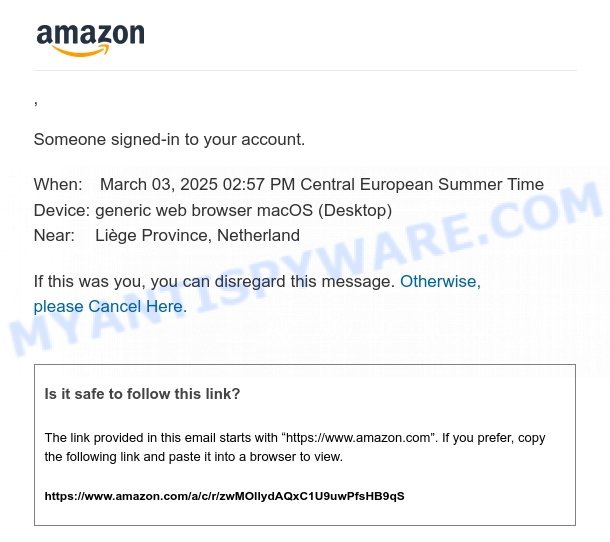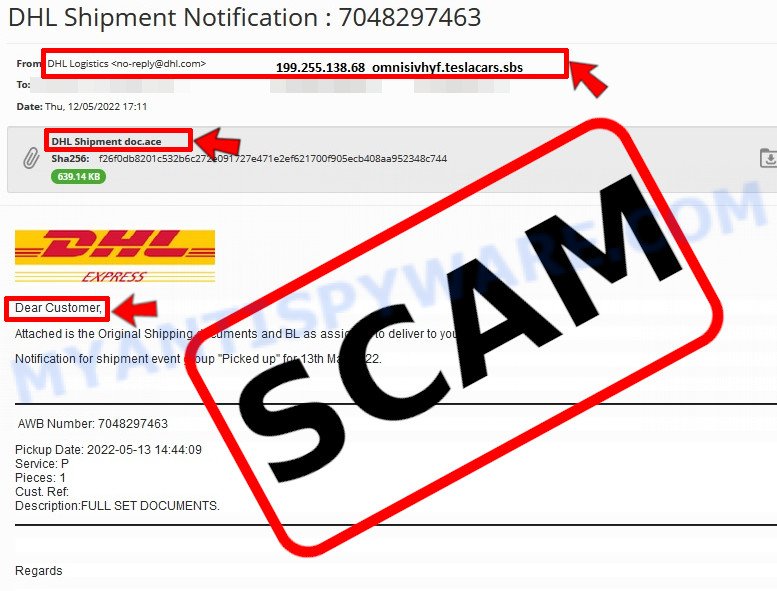Have you come across an email that claims someone signed into your Amazon account? The email then prompts you to “Cancel Here” if it wasn’t you.

Question: Is it safe to click on this link and follow the instructions in the email?
Investigation Findings: This email is a scam. It uses tricks like email spoofing to make it look like it’s from Amazon. When you see “Otherwise, please Cancel Here”, be cautious, because clicking on such a link actually leads you to a phishing website named abordar.online. Furthermore, the email tries to fool you with a legitimate-looking Amazon link, but it’s a trap.
Answer: The email you received is a fraudulent phishing attempt designed to steal your personal information. 💡 To protect yourself from phishing attacks like this, do not click on any links or buttons in the email. Instead, if you’re concerned, manually type Amazon’s website address in your browser, or use the Amazon app to check your account directly. Additionally, never share login information and regularly update your passwords for extra security.
A typical “Amazon Sign-in attempt Notification Alert” scam email reads as follows:
Subject: Amazon Sign-in attempt Notification Alert
from: account-update@amazon.com
to: xxxxxAmazon
Someone signed-in to your account.
When: March 03, 2025 02:57 PM Central European Summer Time
Device: generic web browser macOS (Desktop)
Near: Liège Province, Netherland
If this was you, you can disregard this message. Otherwise, please Cancel Here.
Is it safe to follow this link?
The link provided in this email starts with “https://www.amazon.com”. If you prefer, copy the following link and paste it into a browser to view.https://www.amazon.com/a/c/r/zwMOllydAQxC1U9uwPfsHB9qS
The Amazon Sign-in attempt Notification Alert Email is a scam. This scam targets unsuspecting users by pretending to be an official message from Amazon to trick them into clicking a link. The email suggests that there’s been a sign-in attempt on your account and urges you to confirm whether it was you by clicking a suspicious link.
The scammers use email spoofing to make the email appear legitimate. The genuine-looking link displayed in the email is fake; when you hover over “Otherwise, please Cancel Here”, it actually leads to a phishing website at abordar.online. This phishing website may be designed to steal your Amazon login details or other sensitive information.
💡 If you get a similar email, do not click on any links. Instead, go directly to Amazon’s website by typing the URL yourself or using a bookmark. You can check the security of your account there. Report the phishing email to Amazon and delete it to protect yourself and your information.
Summary Table
| Name | Amazon Sign-in Attempt Scam |
| Type | Phishing Email |
| Email Address | account-update@amazon.com |
| Phishing Website | abordar.online |
| Disguised as | Amazon Sign-in Notification |
📧 What to Do When You Receive the “Amazon Sign-in attempt Notification Alert” Scam Email
We advise everyone who receives this email to follow the simple steps below to protect yourself from potential scams:
- ❌ Do not believe this email.
- 🔒 NEVER share your personal information and login credentials.
- 📎 Do not open unverified email attachments.
- 🚫 If there’s a link in the scam email, do not click it.
- 🔍 Do not enter your login credentials before examining the URL.
- 📣 Report the scam email to the FTC at www.ftc.gov.
If you accidentally click a phishing link or button in the “Amazon Sign-in attempt Notification Alert” Email, suspect that your computer is infected with malware, or simply want to scan your computer for threats, use one of the free malware removal tools. Additionally, consider taking the following steps:
- 🔑 Change your passwords: Update passwords for your email, banking, and other important accounts.
- 🛡️ Enable two-factor authentication (2FA): Add an extra layer of security to your accounts.
- 📞 Contact your financial institutions: Inform them of any suspicious activity.
- 🔄 Monitor your accounts: Keep an eye on your bank statements and credit reports for any unusual activity.
🔍 How to Spot a Phishing Email
Phishing emails often share common characteristics; they are designed to trick victims into clicking on a phishing link or opening a malicious attachment. By recognizing these signs, you can detect phishing emails and prevent identity theft:

💡 Here Are Some Ways to Recognize a Phishing Email
- ✉️ Inconsistencies in Email Addresses: The most obvious way to spot a scam email is by finding inconsistencies in email addresses and domain names. If the email claims to be from a reputable company, like Amazon or PayPal, but is sent from a public email domain such as “gmail.com”, it’s probably a scam.
- 🔠 Misspelled Domain Names: Look carefully for any subtle misspellings in the domain name, such as “arnazon.com” where the “m” is replaced by “rn,” or “paypa1.com,” where the “l” is replaced by “1.” These are common tricks used by scammers.
- 👋 Generic Greetings: If the email starts with a generic “Dear Customer”, “Dear Sir”, or “Dear Madam”, it may not be from your actual shopping site or bank.
- 🔗 Suspicious Links: If you suspect an email may be a scam, do not click on any links. Instead, hover over the link without clicking to see the actual URL in a small popup. This works for both image links and text links.
- 📎 Unexpected Attachments: Email attachments should always be verified before opening. Scan any attachments for viruses, especially if they have unfamiliar extensions or are commonly associated with malware (e.g., .zip, .exe, .scr).
- ⏰ Sense of Urgency: Creating a false sense of urgency is a common tactic in phishing emails. Be wary of emails that claim you must act immediately by calling, opening an attachment, or clicking a link.
- 📝 Spelling and Grammar Errors: Many phishing emails contain spelling mistakes or grammatical errors. Professional companies usually proofread their communications carefully.
- 🔒 Requests for Sensitive Information: Legitimate organizations typically do not ask for sensitive information (like passwords or Social Security numbers) via email.
✅ Conclusion
We hope this article has helped you understand more about the “Amazon Sign-in attempt Notification Alert” Scam Email and how to avoid falling victim to scammers. If you have received a phishing email that is similar but not identical to the example above, please post it in the comments section of this article. This helps us warn other users about potential scams and improve our resources to protect you better. Stay safe and vigilant! 🛡️















